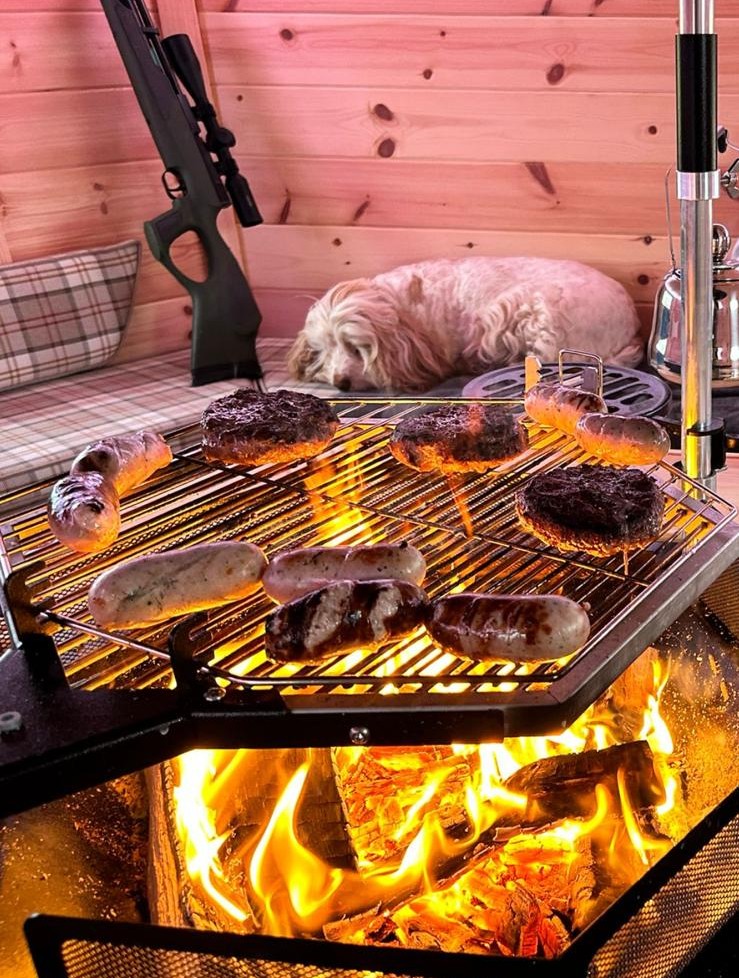Not sure what goes on beneath a cabin when we install it? Or how a base works? It's all here!
It’s all about the base ‘bout the base
Yes I know it is corny, but there we go. This is going to be quite a short piece as there really isn’t a massive amount to say about bases, it is still important that you have all the knowledge so that you can decide which one is best, so hopefully at the end of this, you will be an Ace of bases (I will get my coat)
There are 4 base types you can have under your cabin. A concrete/hard standing base, a pegged base, a frame base or a hybrid base. I shall explain.
Concrete/Hard standing Base
If you are on an island, or the extremities of Scotland, a concrete base is the best option for you. You can have them in other parts of Scotland if you wish, they are not exclusively for these areas.
You can get someone local to install this with our instructions (there is no room for creativity here, do exactly what they say, with those sizes etc) and you will be grand for us coming to install. We then put a frame on top of this, to help with airflow.
If you already have something in your garden such as a patio or decking, then we can again put a frame on here, and your cabin can sit on this. Frames go on top of the concrete, decking or patio to allow for more airflow under the cabin.
Pegged base – timber or composite?
This is like the framing that goes in for decking. It is postcreted into the ground, and then frame on top, with the cabin on top of that. This is great for an areas that have grass there presently, or are a little lumpy/bumpy. Pegged bases are superb for allowing airflow to the cabins, so long as no one does anything daft and closes them in (more on that shortly).
Timber or composite both work extremely well. The difference is that if you are in a wetter area, you may get more longevity with the composite. The timber does not touch the ground at any time, so this should not be affected, and it is treated. Just keep things like leaves etc clear of it if you can. You can choose whether you want a timber peg, or composite pegs. All good this end.
Frame base
if you are one of the lucky ones, and already have an area that a cabin can sit on – deck, hard standing, concrete, monoblocks, existing patio, then you will only need a frame to sit here, which lifts the cabin and helps with airflow.
Hybrid
if you have a bit of a hard area, and then a bit of grass, then we can do a half and half, or 50/50 where part of the base is framed, and part is pegged. This is great if you have an old building coming down and want to install a cabin or a studio on what is already there, or for whatever reason, there is a concrete/hard area, that needs to be covered up, but the cabin is going to be a little bigger. We can use that area up with one of these bases very easily. It still gives you the critical airflow, and uses up the space really well.
A few pointers
There are always some exceptions to the rules, and some people who think they can bypass the laws of physics and wonder why things aren’t working. So for those people, and your good selves, here are a few pointers and reminders –
No, we cannot, and will not install on a metal base like the ones at the show site. Never. It is not going to happy, so please do not ask. Nor are we going to install on sleepers. If you want to get that creative, then we are not the company for you.
If your cabin is going onto an existing deck, make sure the deck is strong enough. We take no responsibility for putting a cabin on a deck that ends up rotting out in a few years. We would likely refuse to install it in the first place. If we do install, then we are going to cut a hole in it, and you will have to open the back up. Why? See the next point.
Once installed, if you seal in all the base and pegs, and wonder why you have a smokey hut, then go and research about how a fire works. It has to have airflow. And you have just sealed it off entirely. If you are not a fan of seeing the base, which is fair enough, hide it at the front, and keep the back open.
Furry beasties, or winged ones – use the plug under the bbq, and seal up the sides of the porch. You can put chicken wire over the top of the chimney if you get birds flying down inside. Or maybe get a cat?
Snow – the reason I mention this is because it happened once, to us and a few of our customers. When the Beast from the East came, it brought the finest and dustiest snow ever, with a right good gale at the back of it. This snow managed to blow up between the two layers of the roof, and in some cabins, create a rather interesting indoor snow effect. Ours included (and our sheds!). A good hot fire, and some towels, saw it all disappear, and everyone happen with no further issues reported. There is zero we can do about that freak event, other than be prepared should another one ever lurk about.
This list is not exhaustive. And I am sure there will be other points that we have forgotten about. The main thing is for you to understand that the base is critical to the success of the cabin working on a natural airflow, and this making it incredibly safe for you and your family. That flow means there is nothing to break like a fan, which would render your cabin unusable until it was fixed.
Installing your base – when will this happen?
In most instances, we will install your base on the same day as your cabin, so that the disruption to your world is minimal. Sometimes however, we may do this beforehand. This can be for a number of reasons. Logistics (such as we might be in the area) and geography are a big one. It can really help the teams’ day if we are able to put the base in beforehand if you are far away from us, and it happens to coincide with another cabin near you. Other reasons can be the size of the cabin. If you are going to be getting a larger cabin, or one with an extension, it can save a lot of time, and give a better result to have the base in beforehand. This will come down to logistics again, as it might not be feasible to do this before, but all of this will be ironed out at the point of ordering and when we get into discussing such things. We know that each site and situation is unique for your hut or cabin, so each one will be treated individually.
Whenever we do come to do this, be it before the install date, or on the day of, we politely ask that you have decided where the cabin is to go, and the orientation of it before we get there, as the team has a long day ahead of them, and knowing where they are going, and what where (door wall, window walls etc) really helps ease the pressure. The team will ask you when they get there, and should something appear that they feel could impact this, they will let you know, so it would never hurt to have a Plan B if you can. You are of course welcome to discuss this with us beforehand too, and we can pass this on before the team leave so they have the information before they arrive with you.
Aftercare of your base
There is little you need to do with your base going forward. If it is visible, you can stain it with your cabin, which will not harm the wood and give it a little more protection. If you cover it, very little to zero will be needed. In-fill will maybe need some stain over time. It doesn’t hurt to keep it clear of things like leaves, and other organic matter than can creep up. The most important thing is to ensure that it is never lying in water for any length of time as this appears to be the most destructive force against our cabins (other than the VERY occasional tree that uprooted itself and landed smack down in the middle of one…..) and can cause all sorts of issues if not attended to right away. Your base is expected to last years like your cabin due to the wood we use. So if you look after it, it should be around as long as your cabin. IF you can, we have found a rim of chippy stones around the cabin can sometimes help with run off to get that water away. We do appreciate that this can’t be done for every cabin.
So there you have it. All the info in our collective brains about bases we can think of for BBQ Huts. The biggest take away for us is the airflow. This is critical for the cabin to work.
01738 850203




